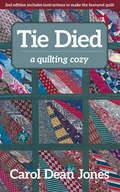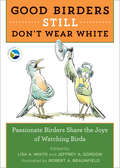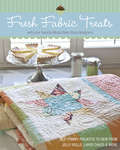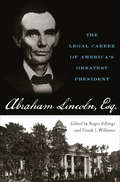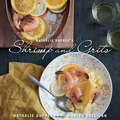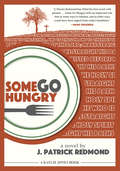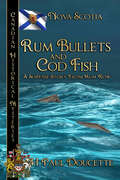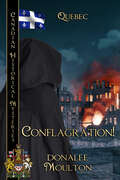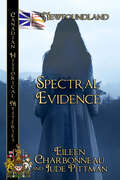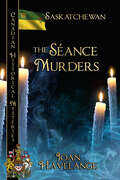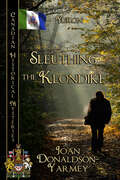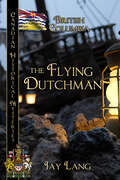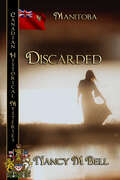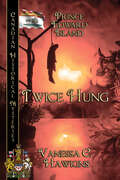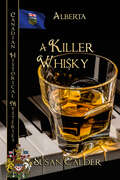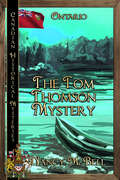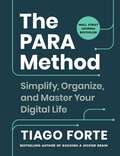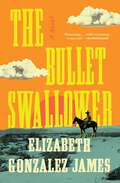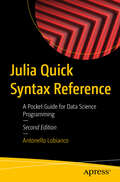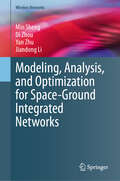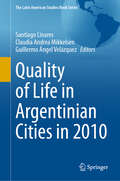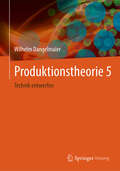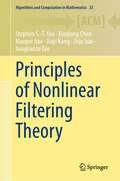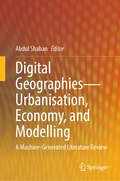- Table View
- List View
Tie Died: A Quilting Cozy
by Carol Dean JonesFirst in the mystery series starring a senior sleuth with a passion for quilting—and quizzing suspects…Includes a bonus pattern! Sarah Miller&’s forty-year-old daughter, Martha, has been relentlessly encouraging her to leave her longtime home and settle into a retirement community—and now sixtysomething widow Sarah has reluctantly given in. It&’s a tough adjustment, but she&’s a tough lady—and she&’s going to get her bearings and build a new life for herself. She&’s happy when she starts meeting some of her fellow residents and making friends. But then, one of them is murdered—and Sarah and her feisty friend Sophie are determined to find the killer…
Good Birders Still Don't Wear White: Passionate Birders Share the Joy of Watching Birds
by Kenn Kaufman Michael O'Brien Pete Dunne Bill Thompson III Julie Zickefoose Richard Crossley Robert A. BraunfieldAvid North American birders share wit, wisdom, advice, and what fuels their passion for birds. Birding gets you outside, helps you de-stress, exercises your body and mind, puts your day-to-day problems in perspective, and can be lots of fun. Birders know this, and in this collection of thirty-seven brief essays, birders from diverse backgrounds share their sense of wonder, joy, and purpose about their passion (and sometimes obsession). From the Pacific Ocean to Central Park, from the rainforest in Panama to suburban backyards—no matter what their habitat, what good birders have in common is a curiosity about the natural world and a desire to share it with others. In these delightful essays, each accompanied by an endearing drawing, devoted birders reveal their passion to be fulfilling, joyful, exhilarating, and maybe even contagious. Contributors include many well-known birders, such as Richard Crossley, Pete Dunne, Kenn Kaufman, Michael O'Brien, Bill Thompson, and Julie Zickefoose—and a portion of the proceeds goes to the American Birding Association, North America's largest membership organization for active birders.
Fresh Fabric Treats: 16 Yummy Projects to Sew from Jelly Rolls, Layer Cakes & More with Your Favorite Moda Bake Shop Designers
by Moda Bake ShopUse your stash of precuts from the popular fabric company to treat yourself to quilts, table runners, pillows, totes and more! In this deliciously inspiring book, 15 popular project designers from the Moda Bake Shop serve it up in style! Their recipes are simple: Start with a mix of Moda precuts, sprinkle in some eye-catching details, and then top it all off with creative garnishes. Easy-to-follow instructions, vibrant photographs, and a variety of clever tips make these projects a snap to complete! &“Is it the designers, the precuts or all the yummy Moda fabrics that draw us into this book? Oh heck, it&’s all three! . . . In this case, the quilts are simple and doable (April in Paris is sooo pretty!), but the shine really comes from the other sewn projects. Just a bit more involved than beginner, Roslyn Mirrington&’s Jewelry Wallet is so incredibly girly and useful for those of us who travel that our fingers were itching to make it. Jenny Garland&’s Zippidy Doodle Bag is practically a no-brainer for kid-accompanied outings. (Skeptical? Just think about how many shoes you can try on while your 4-year-old works on the Cars 2 coloring book.) And Kimberly Walus&’ Pack &’N&’ Go Tote with a matching Sewing Kit is a fabulous combo for us sew-types. A perfect buy for gift givers or those of you drowning in precuts.&”—Generation Q Magazine
Abraham Lincoln, Esq.: The Legal Career of America's Greatest President
by Roger Billings and Frank J. WilliamsLincoln scholars explore the president&’s law career in this informative volume, examining his legal writings on matters from ethics to the Constitution. As our nation's most beloved and recognizable president, Abraham Lincoln is best known for the Emancipation Proclamation and for guiding our country through the Civil War. But before he took the oath of office, Lincoln practiced law for nearly twenty-five years in the Illinois courts. In Abraham Lincoln, Esq., notable historiansexamine Lincoln's law practice and the effect it had on his presidency and the country. This volume offers new perspectives on Lincoln&’s work in Illinois as well as his time in Washington. Each chapter offers an expansive look at Lincoln's legal mind and covers diverse topics such as Lincoln's legal writing, ethics, Constitutional law, and international law. Abraham Lincoln, Esq. emphasizes this overlooked period in Lincoln's career and sheds light on Lincoln's life before he became America&’s sixteenth president.
Nathalie Dupree's Shrimp and Grits
by Nathalie Dupree Marion SullivanThe James Beard Award-winning cookbook author updates her comfort food classic with all-new photography and new recipes from Southern chefs. Nathalie Dupree was ahead of the curve with the first edition of Shrimp and Grits. Now this Lowcountry combo is found not just across the south, but on restaurant menus all around the country. This updated edition features new recipes from some of today&’s finest southern chefs and restaurants, including Donald Barickman&’s Pan-Fried Grits Cakes with Shrimp, Leeks & Tomato Gravy, and Charleston Grill&’s Shrimp with Madeira & Parmesan Grits.
Some Go Hungry
by J. Patrick RedmondA gay man returns to his conservative hometown in a tale of memory and murder inspired by true events: &“An emotionally resonant, page-turning story.&”—BooklistSome Go Hungry is a fictional account drawn from the author&’s own experiences working in his family&’s provincial Indiana restaurant, and wrestling with his sexual orientation, in a town that was rocked by the scandalous murder of his gay high school classmate in the 1980s.Now a young man who has embraced his sexuality, Grey Daniels returns from Miami Beach, Florida, to Fort Sackville, Indiana, to run Daniels&’ Family Buffet for his ailing father. Understanding that knowledge of his sexuality may reap disastrous results on his family's half-century-old restaurant legacy—a popular Sunday dinner spot for the after-church crowd—Grey struggles to live his authentic, openly gay life. But he is truly put to the test when his former high school lover—and fellow classmate of the murdered student—returns to town as the youth pastor and choir director of the local fundamentalist Christian church.Some Go Hungry is the story of a man forced to choose between the happiness of others and his own joy, all the while realizing that compromising oneself—sacrificing your soul for the sake of others—is not living, but death.&“This literary mystery follows Grey Daniels on a return trip to his hometown of Fort Sackville, Indiana where, decades earlier, one of his gay classmates was brutally murdered. While visiting, Grey must confront a painful past riddled in homophobia, secrets, religious hypocrisy and fear.&”—Queerty&“Some Go Hungry is at its best when confronting religious prejudice, and is even pulse-quickening when the narrator sits through one of his friend's sermons aimed directly at him....Only someone who has grown up in rural America could write so convincingly of the pressures there. It's also refreshing to find a book that relates the experience of being gay somewhere other than in a large city.&”—Gay & Lesbian Review &“Tells an important tale that in some ways is timeless, and in other ways could have been ripped from today's headlines.&”—Mark Childress, author of Crazy in Alabama
Rum, Bullets and Codfish: Canadian Historical Mysteries (Canadian Historical Mysteries)
by H. Paul DoucetteThe year is 1924 and Prohibition is spawning a new breed of criminal. Rum runners. Jerome Conway is the undercover investigation officer whose job it is to uncover the ringleaders behind the illegal importation of liquor from St. Pierre, Miquolon, and the Caribbean destined for distribution to the US based mob. His task is a complicated and dangerous one which leads him into the dark corners of illegal activities and the underbelly of society. If he is to be successful in his quest and emerge unscathed, Conway will need to be smarter and quicker than the felons he is chasing.
Conflagration: Canadian Historical Mysteries (Canadian Historical Mysteries)
by donnalee MoultonOn a warm spring day in April 1734, a fire raged through Montreal’s merchant quarters. When the flames finally died, 46 buildings – including the Hôtel-Dieu convent and hospital – had been destroyed. Within hours, rumors ran rampant that Marie-Joseph Angélique, an enslaved Black woman fighting for her freedom, had started the fire with her white lover, Claude Thibault. Less than 24 hours later, Angelique was sitting in a prison cell. Her lover was nowhere to be found. More than 20 witnesses appeared before the judge, all claiming Angélique was the arsonist. But no one saw her set the fire.
Spectral Evidence: Canadian Historical Mysteries (Canadian Historical Mysteries)
by Eileen Charbonneau Jude PittmanSeventeen year-old Newfoundlande rCharlotte Jaddore loves nothing more than learning sacred healing arts from the elders of her Mi’kmaq and Beothuk grand-mothers. But the year is 1692 and her fathe rneeds he rhelp .Thei rAmerican cousins in Salem, Massachusetts have been accused of witchcraft. Will Charlotte help her father fight for their lives.
The Séance Murders: Canadian Historical Mysteries (Canadian Historical Mysteries)
by Joan Havelange1908: Regina,Saskatchewan, the railroad hub of the prairies,is booming. The foxtrot isthe latest craze hitting the dance halls, andsilent moviesare all the rage. But it’s thenewest fad, séances, that intrigues Myrtle Vanhoff. Myrtle is tired of the constraints put on her by her father, Reginald Vanhoff, a lumber baron, and her mother, Amelia. Her mother is d etermined to make her and her daughter’s mark on Regina’s burgeoning social scene. But Myrtle has other ideas. On a lark, the rebellious young woman convinces her twin brother, Leopold, to attend Madame Scarlatta’s notorious sé ance s. They find more than re stless spirits . Someone murders a bereaved patron while everyone at the table is holding hands. Myrtle and Leopold are determined to find out who and how.
Sleuthing the Klondike: Canadian Historical Mysteries (Canadian Historical Mysteries)
by Joan Donaldson-YarmeyDavid Gastrell is a remittance man in Canada and he is missing. His last telegram home said he was headed to Dawson City, Yukon. His sister Helen and her lady’s maid, Mattie Lewis, arrive in Victoria, British Columbia, from England. Helen hires Detective Baxter Davenport to go with her to Dawson City, Yukon, and help her locate David for their father. Baxter Davenport has his doubts about travelling north with two women. He will have a job to do and can’t be looking after them. Mattie has worked for the family for years and remembers David better than Helen does. She also has her own motive for wanting to find him.
The Flying Dutchman: Canadian Historical Mysteries (Canadian Historical Mysteries)
by Jay Langa dangerous stranger visits a sleepy town, murder on Vancouver Island,a notorious criminal beguilesaninnocent girl, thelast hanging in New Westminster,apolice officergunned down, an unexpected ending down,aWestCoast historicalthriller,an unexpected ending
Discarded: Canadian Historical Mysteries (Canadian Historical Mysteries)
by Nancy M. BellWhen the British arrived in Winnipeg in the 1800s it was convenient for the men to take Metis wives. They were called a la vacon du pays – according to the custom of the country. These women bore the brunt of ensuring survival in the harsh environment. Without them the British army and fur traders would not have survived the brutal winters. However, as society evolved it became accepted that wives must be white, schooled in British ways, fashionable in the European sense and married by the Anglican church. The Metis wives and their ‘country born’ offspring were thrown out and forced to fend for themselves. The unrepentant husbands continued to live comfortably with their ‘new’ wives. It was inevitable that some discarded wives did not accept their fate quietly and hard feelings on both sides were unavoidable. When the bodies of two discarded Metis wives, Marguerite and Marie-Anne, are found floating in the Red River, Guilliame Mousseau, sets out to get to the bottom of his sister Marguerite’s murder.
Twice Hung: Canadian Historical Mysteries (Canadian Historical Mysteries)
by Vanessa HawkinsEthel Arsenault's been hearing noises in her brother's house ever since she arrived from Summerside, but when he turns up dead, could the supernatural be to blame, or her sister-in-law Dolly whose been caught talking to herself when night falls? Ethel isn't sure, nor is she happy when she's left alone to care for Ernest's estate. Was her brother the victim of sweet, little Dolly Arsenault, or is some other sinister force at work? The city of Charlottetown is quick to point the blame at Dolly, but now Ethel has been hearing things in the house... Or is it just her imagination.
A Killer Whisky: Canadian Historical Mysteries (Canadian Historical Mysteries)
by Susan CalderThe 1918 influenza pandemic strikes Calgary, Alberta, Canada. The Great War rages overseas. While her husband fights in Europe, Katharine works in a doctor’s office to support her children and her brother, a wounded veteran. One night their neighbour suddenly takes sick and dies. The attending doctor concludes the man died from influenza, but Katharine suspects someone laced his whisky with a drug that mimics the deadly flu’s symptoms.
The Tom Thomson Mystery: Canadian Historical Mysteries (Canadian Historical Mysteries)
by Nancy M. BellTom Thomson, one of the painters belonging to the Canadian Group of Seven, disappearedon Canoe Lake in 1917. His death was confirmed eight days later when his body wasrecovered. Did he commit suicide or was there foul play at work? Was he murdered bysomeone who owed him money, by a pregnant girlfriend or was it just an accident? His deathon Canoe Lake leaves us with many questions.
The PARA Method: Simplify, Organize, and Master Your Digital Life
by Tiago ForteThis accessible guide expands upon the &“well-written, cogent, and useful&” (David Allen, author of Getting Things Done) bestselling Building a Second Brain with actionable advice on how to improve your digital life in just a few minutes.Living a modern life requires juggling a ton of information. But we were never taught how to manage this information effectively so that we can find what we need when we need it. In The PARA Method, Tiago Forte outlines a simple and intuitive four-step system that will help us sort all the information flooding our brains into four major categories—Projects, Areas, Resources, and Archives—allowing us to manage our commitments while achieving our goals and dreams. -Projects are specific, short-term efforts that you are actively working on with a certain goal in mind, such as completing a website or renovating your bathroom. -Areas are the larger, ongoing areas of responsibility (health, finances, etc.) that encompass those specific projects. -Resources include content on a range of topics you&’re interested in or that could be useful for your projects and areas. -Archives include anything from the previous three categories that is now inactive, but you want to save for future reference. With his easy-to-understand and engaging voice, Forte outlines his best practices and tips on how to successfully implement PARA, along with deep dives on everything from how to adopt habits to stay organized to how to use this system to enhance your focus. The PARA Method can be implemented in just seconds but has the power to transform the trajectory of your work and life using the power of digital organization.
The Bullet Swallower: A Novel
by Elizabeth Gonzalez JamesA &“mesmerizing...wildly entertaining&” (The Boston Globe) magical realism western in the vein of Cormac McCarthy meets Gabriel García Márquez, The Bullet Swallower follows a Mexican bandido as he sets off for Texas to rob a train, only to encounter a mysterious figure who has come, finally, to collect a cosmic debt generations in the making.In 1895, Antonio Sonoro is the latest in a long line of ruthless men. He&’s good with his gun and drawn to trouble but he&’s also out of money and out of options. A drought has ravaged the town of Dorado, Mexico, where he lives with his wife and children, and so when he hears about a train laden with gold and other treasures, he sets off for Houston to rob it—with his younger brother Hugo in tow. But when the heist goes awry and Hugo is killed by the Texas Rangers, Antonio finds himself launched into a quest for revenge that endangers not only his life and his family, but his eternal soul. In 1964, Jaime Sonoro is Mexico&’s most renowned actor and singer. But his comfortable life is disrupted when he discovers a book that purports to tell the entire history of his family beginning with Cain and Abel. In its ancient pages, Jaime learns about the multitude of horrific crimes committed by his ancestors. And when the same mysterious figure from Antonio&’s timeline shows up in Mexico City, Jaime realizes that he may be the one who has to pay for his ancestors&’ crimes, unless he can discover the true story of his grandfather Antonio, the legendary bandido El Tragabalas, The Bullet Swallower. A family saga that&’s epic in scope and loosely based on the author&’s own great-grandfather, The Bullet Swallower is &“rich in lyrical language, gripping action, and enchanting magical realism&” (Esquire). It tackles border politics, intergenerational trauma, and the legacies of racism and colonialism in a lush setting with stunning prose that asks who pays for the sins of our ancestors and whether it is possible to be better than our forebearers.
Julia Quick Syntax Reference: A Pocket Guide for Data Science Programming
by Antonello LobiancoLearn the Julia programming language as quickly as possible. This book is a must-have reference guide that presents the essential Julia syntax in a well-organized format, updated with the latest features of Julia’s APIs, libraries, and packages. This book provides an introduction that reveals basic Julia structures and syntax; discusses data types, control flow, functions, input/output, exceptions, metaprogramming, performance, and more. Additionally, you'll learn to interface Julia with other programming languages such as R for statistics or Python. At a more applied level, you will learn how to use Julia packages for data analysis, numerical optimization, symbolic computation, and machine learning, and how to present your results in dynamic documents. The Second Edition delves deeper into modules, environments, and parallelism in Julia. It covers random numbers, reproducibility in stochastic computations, and adds a section on probabilistic analysis. Finally, it provides forward-thinking introductions to AI and machine learning workflows using BetaML, including regression, classification, clustering, and more, with practical exercises and solutions for self-learners. What You Will Learn Work with Julia types and the different containers for rapid development Use vectorized, classical loop-based code, logical operators, and blocks Explore Julia functions: arguments, return values, polymorphism, parameters, anonymous functions, and broadcasts Build custom structures in Julia Use C/C++, Python or R libraries in Julia and embed Julia in other code. Optimize performance with GPU programming, profiling and more. Manage, prepare, analyse and visualise your data with DataFrames and Plots Implement complete ML workflows with BetaML, from data coding to model evaluation, and more. Who This Book Is For Experienced programmers who are new to Julia, as well as data scientists who want to improve their analysis or try out machine learning algorithms with Julia.
Modeling, Analysis, and Optimization for Space-Ground Integrated Networks (Wireless Networks)
by Yan Zhu Di Zhou Min Sheng Jiandong LiThis book delves into the burgeoning field of space-ground integrated networks (SGINs), focusing on the evolution, architecture and application scenarios of large satellite constellations. As global communication demands surge, the next-generation SGINs are transitioning towards large-scale, hyperscale, and hierarchical constellations to address diverse user needs, such as ultra-long-haul, high-speed and instantaneous communications. Through an in-depth exploration of network working principles, traffic and link modeling, and performance analysis and optimization methods, this book offers substantial guidance to readers. It aims to uncover pathways for enhancing network service capability and to establish a solid theoretical foundation for the future development of mega-satellite constellations within the SGIN framework. Furthermore, this book provides a comprehensive analysis of SGINs, examining its network architecture, developmental trajectory and application scenarios. It delves into the core challenges faced by SGINs and proposes response strategies. This book introduces various methods for service capability modeling and quantitative performance analysis across different traffic types, emphasizing the intricate relationships between network performance, traffic patterns, nodes, links and network characteristics. Through an exhaustive study of large-scale satellite network operations, this book illuminates avenues for improving network service capacity, thereby paving the way for theoretical guidance and technical support for future ultra-large-scale SGINs. By offering systematic analyses and insights, this book aims to equip readers with a profound understanding and practical guidance for SGIN network planning and optimization. It also highlights future trends and potential application scenarios in the evolving landscape of network technology. This book targets advanced level students, professors, researchers and scientists working in the fields of telecommunications, satellite communications and network engineering, who wish to gain an in-depth understanding of SGIN principles, performance analysis and optimization techniques. Practitioners working in aerospace or telecommunications policy making to gain insights into future trends and challenges in satellite network design and optimization will want to purchase this book as well.
Quality of Life in Argentinian Cities in 2010 (The Latin American Studies Book Series)
by Claudia Andrea Mikkelsen Santiago Linares Guillermo Ángel VelázquezThis book introduces a quality of life index that compares the intra-urban particularities of 23 cities in the Argentine Republic. Integrating demographic size, functional specialization, and regional location, the chapters employ a standard set of variables to assess socioeconomic and environmental inequality and wellbeing. A result of collaboration between 33 contributors from institutions around the country, the book provides a rich assessment of the mechanisms and processes by which the residential areas of Argentinian cities form, change, develop, and decline. Consistent measures of education, health, housing, and environmental wellbeing allow for deep examinations of each area and meaningful comparisons between them. The book also explores patterns that recur in multiple cases. Redevelopment and renewal processes in central and old areas of cities can lead to the creation or reenergization of modern, high-density neighborhoods that, benefitting from new construction and integrated commercial and service areas, exhibit high quality of life indices. Urban expansion stands out as a process that often results in or reinforces socio-spatial segregation: New, exclusive, low-density residential neighborhoods with single-family homes and green areas tend to have a high level of quality of life, thanks to good education, health services, housing, and natural amenities. In contrast, low-income neighborhoods with precarious housing, limited access to health and education services, and unfavorable environments exhibit lower quality of life measures. Increasingly common gated communities—with private security, exclusive services, and (internally) shared recreational spaces—reinforce this pattern of segregation. Analyzing the quality of life in different Argentinian cities is important to understanding the living conditions of the inhabitants, identifying areas for improvement, and supporting the development of inclusive and sustainable policies. These measurements can facilitate more just and prosperous environments for all citizens.
Produktionstheorie 5: Technik entwerfen
by Wilhelm DangelmaierIn dem mehrbändigen Werk zur „Produktionstheorie“ sollen erstmalig die heute aus der Praxis geborenen Produktionsmodelle und –verfahren mathematisch begründet hergeleitet und so auch der Produktionswirtschaft eine wissenschaftliche Grundlage gegeben werden. Dem „wir haben unser Unternehmen halt so organisiert und das hat sich bewährt“ soll eine konstruktivistische Sicht beiseite gestellt und so die vielen deskriptiv angelegten „Fabrikbetriebslehren“ abgelöst werden.Im vorliegenden Band 5, „Technik entwerfen“ wollen wir eine Theorie des Entwerfens von Technik angehen und uns Gedanken über das Denken und Handeln des Ingenieurs machen. Dieses Denken und dieses Handeln sind immer rekursiv: Wir entwerfen ein Technisches System‘ zur Herstellung eines Technischen Systems‘‘ zur Herstellung eines Technischen Systems‘‘‘. Das könnte bspw. das Entwerfen eines Produktionssystems zur Herstellung von Spritzgussmaschinen zur Herstellung von Haushaltföhns sein, wenn dabei initial nur festliegt, welchen Föhn der Markt letztendlich verlangt. Natürlich gibt es hier eine riesige Bandbreite möglicher Lösungen; wir brauchen nur eine, die für uns beste. Den dafür notwendigen Entscheidungs- und Auswahlprozess soll dieses Buch vorbereiten und/oder begleiten.
Principles of Nonlinear Filtering Theory (Algorithms and Computation in Mathematics #33)
by Stephen S.-T. Yau Xiuqiong Chen Xiaopei Jiao Jiayi Kang Zeju Sun Yangtianze TaoThis text presents a comprehensive and unified treatment of nonlinear filtering theory, with a strong emphasis on its mathematical underpinnings. It is tailored to meet the needs of a diverse readership, including mathematically inclined engineers and scientists at both graduate and post-graduate levels. What sets this book apart from other treatments of the topic is twofold. Firstly, it offers a complete treatment of filtering theory, providing readers with a thorough understanding of the subject. Secondly, it introduces updated methodologies and applications that are crucial in today’s landscape. These include finite-dimensional filters, the Yau-Yau algorithm, direct methods, and the integration of deep learning with filtering problems. The book will be an invaluable resource for researchers and practitioners for years to come. With a rich historical backdrop dating back to Gauss and Wiener, the exposition delves into the fundamental principles underpinning the estimation of stochastic processes amidst noisy observations—a critical tool in various applied domains such as aircraft navigation, solar mapping, and orbit determination, to name just a few. Substantive exercises and examples given in each chapter provide the reader with opportunities to appreciate applications and ample ways to test their understanding of the topics covered. An especially nice feature for those studying the subject independent of a traditional course setting is the inclusion of solutions to exercises at the end of the book. The book is structured into three cohesive parts, each designed to build the reader's understanding of nonlinear filtering theory. In the first part, foundational concepts from probability theory, stochastic processes, stochastic differential equations, and optimization are introduced, providing readers with the necessary mathematical background. The second part delves into theoretical aspects of filtering theory, covering topics such as the stochastic partial differential equation governing the posterior density function of the state, and the estimation algebra theory of systems with finite-dimensional filters. Moving forward, the third part of the book explores numerical algorithms for solving filtering problems, including the Yau-Yau algorithm, direct methods, classical filtering algorithms like the particle filter, and the intersection of filtering theory with deep learning.
Cost & Value Engineering: Digital und nachhaltig im turbulenten Marktumfeld (essentials)
by Dirk A. WeberDigitalisierung, Künstliche Intelligenz und Nachhaltigkeit sind weder aus der betrieblichen Praxis noch aus dem wissenschaftlichen Diskurs wegzudenken. Hinzu kommen Turbulenzen, die seit der Corona-Pandemie und den vielfältigen Krisen sämtliche Marktakteure betreffen und zusätzliche Dynamik schaffen. Cost & Value Engineering (CVE) gehört dabei zu einem wichtigen Hebel des Kosten- und Wertmanagements von Industrieunternehmen. Dieses Essential zeigt, dass sich das CVE als eine wesentliche Aufgabe für technologieintensive Industrieunternehmen etabliert und stark gewandelt hat. Der Einkauf hat somit die Chance, sich von einer Kostenoptimierungsfunktion zu einer wertschaffenden Funktion zu entwickeln. Für diese strategische Weiterentwicklung ist eine enge Kollaboration mit unternehmensinternen Crossfunktionen erforderlich. Das Buch beschreibt, wo Cost & Value-Organisationen heute stehen und was die wesentlichen Gestaltungsdimensionen und Entwicklungstrends sind. Außerdem wird ein Reifegradmodell vorgestellt, das eine Weiterentwicklung von Cost & Value Engineering in den Gestaltungsdimensionen systematisieren kann.
Digital Geographies—Urbanisation, Economy, and Modelling: A Machine-Generated Literature Review
by Abdul ShabanThis machine-generated volume, with chapter introductions by the human expert, of summaries of the existing studies furthers our understanding of the impact of digitalisation on spaces, their imaginations and representations. It brings out the digital territorial and socio-economic digital modelling and representation methods. The virtual spaces, created by GIS, photoshopping, games, etc., have become an area of interest for many as they produce spatial imaginaries having social, political and individual consequences. It delves into the literature on digital capitalism and how it is giving birth to a new mode of expansionary capitalism to reap the surplus values and profits from peripheries and drain the same to the core. It shows how digitalisation has enabled enterprises to operate from a virtual space with strong spatial networks. Mega digital enterprises together control a trillion-dollar economy having massive consequences for digital labour, welfare of consumers, and development geographies. This book explores some critical questions while generating summaries of existing literature: How do imaginaries, models or virtual realities help us comprehend spatialities? How does capitalism relate to digitalism, and with what consequences? How do the cities and mobilities relate to digitalisation? What are the possibilities of re-configuring the man-environmental relations with digital technologies in view of rising pollution and impending climate change? Teachers, researchers, and students engaged in this new area of digital geography, especially in social science and its subfields of sociology, economics, political sciences, anthropology, psychology, development studies, policy studies, social work, urban studies, and planning, will find the volume very useful. For a full picture, the book can be read in combination with its companion volume on ‘Digital Geographies – Theory, Space and Communities’.
